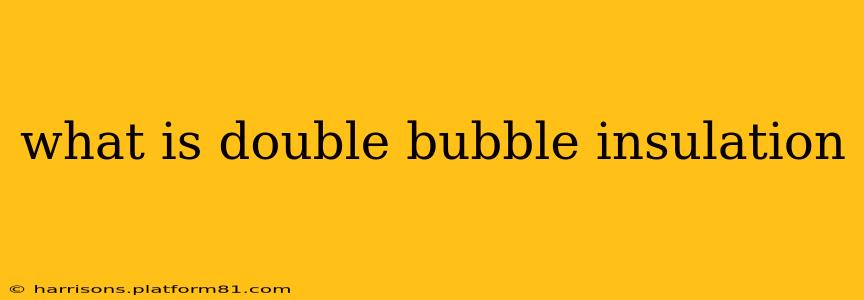Double bubble insulation, also known as reflective insulation or radiant barrier insulation, is a remarkably effective material for improving energy efficiency in buildings. It's gaining popularity as a cost-effective and environmentally friendly solution for reducing energy consumption. But what exactly is it, and how does it work? This comprehensive guide will delve into the specifics of double bubble insulation, answering common questions and highlighting its advantages and disadvantages.
How Does Double Bubble Insulation Work?
Double bubble insulation consists of two layers of thin, usually polyethylene plastic film, separated by a layer of air trapped within a bubble-like structure. This structure resembles the appearance of bubble wrap, hence the name. The air pockets within the bubbles act as an insulator, significantly reducing the transfer of heat through conduction and convection. However, the true magic of double bubble insulation lies in its reflective properties.
The inner and outer surfaces of the plastic film are often coated with a highly reflective material, typically aluminum. This reflective layer minimizes radiant heat transfer – the process by which heat travels in the form of electromagnetic waves. By reflecting radiant heat back to its source, double bubble insulation prevents significant heat loss in the winter and heat gain in the summer. This dual mechanism of trapping air and reflecting radiation makes it a highly effective insulator, particularly in climates with significant temperature fluctuations.
What are the Advantages of Double Bubble Insulation?
Double bubble insulation offers several key advantages over traditional insulation materials like fiberglass or mineral wool:
-
High R-Value for its Thickness: Double bubble insulation boasts a surprisingly high R-value (a measure of thermal resistance) for its relatively low thickness. This makes it ideal for situations where space is limited, such as retrofitting existing structures or insulating attics with low clearance.
-
Lightweight and Easy to Install: Its lightweight nature simplifies installation, making it a DIY-friendly option for many homeowners. It's flexible and can be easily cut to fit various shapes and sizes.
-
Cost-Effective: Compared to other insulation options, double bubble insulation can be more affordable, particularly for large areas. The lower installation costs further contribute to its overall cost-effectiveness.
-
Moisture Resistant: The sealed air bubbles provide a degree of moisture resistance, helping to prevent mold and mildew growth. However, it's not entirely waterproof and should be properly installed to avoid moisture accumulation.
-
Environmentally Friendly: Double bubble insulation is often made from recycled materials and is itself recyclable, making it a more environmentally conscious choice compared to some traditional insulation options.
What are the Disadvantages of Double Bubble Insulation?
While double bubble insulation presents many benefits, it's crucial to acknowledge its limitations:
-
Susceptibility to Punctures: The thin plastic film is susceptible to punctures, potentially compromising its insulation properties. Care must be taken during installation and handling to avoid damage.
-
Limited Vapor Barrier Properties: Unlike some other insulation types, double bubble insulation does not offer a substantial vapor barrier. Proper vapor barrier installation is therefore crucial to prevent moisture problems.
-
UV Degradation: Prolonged exposure to ultraviolet (UV) radiation from sunlight can degrade the plastic film over time, reducing its effectiveness. It's essential to protect it from direct sunlight.
Is Double Bubble Insulation Suitable for All Applications?
Double bubble insulation is best suited for applications where radiant heat transfer is a significant factor, such as in attics, walls, and under floors. It's less effective in situations where conductive heat transfer is dominant. Its effectiveness can also vary based on climate and installation methods.
What is the R-Value of Double Bubble Insulation?
The R-value of double bubble insulation varies depending on the thickness and the specific product. Generally, you can expect R-values ranging from R-4 to R-8 per inch of thickness. It is important to check the manufacturer’s specifications for the exact R-value of the product you are considering.
How Do I Install Double Bubble Insulation?
Installation is relatively straightforward. Generally, it's stapled or taped to framing members, ensuring a tight seal to minimize air leakage. However, proper installation techniques are vital for maximizing its effectiveness. Consulting manufacturer instructions is crucial for best results.
Is Double Bubble Insulation a Good Choice for My Home?
Whether double bubble insulation is a good fit for your home depends on several factors, including your climate, budget, existing insulation, and the specific areas you're looking to insulate. A thorough assessment by a qualified professional can help determine if it's the right solution for your needs. Consider the pros and cons discussed above before making your decision.
